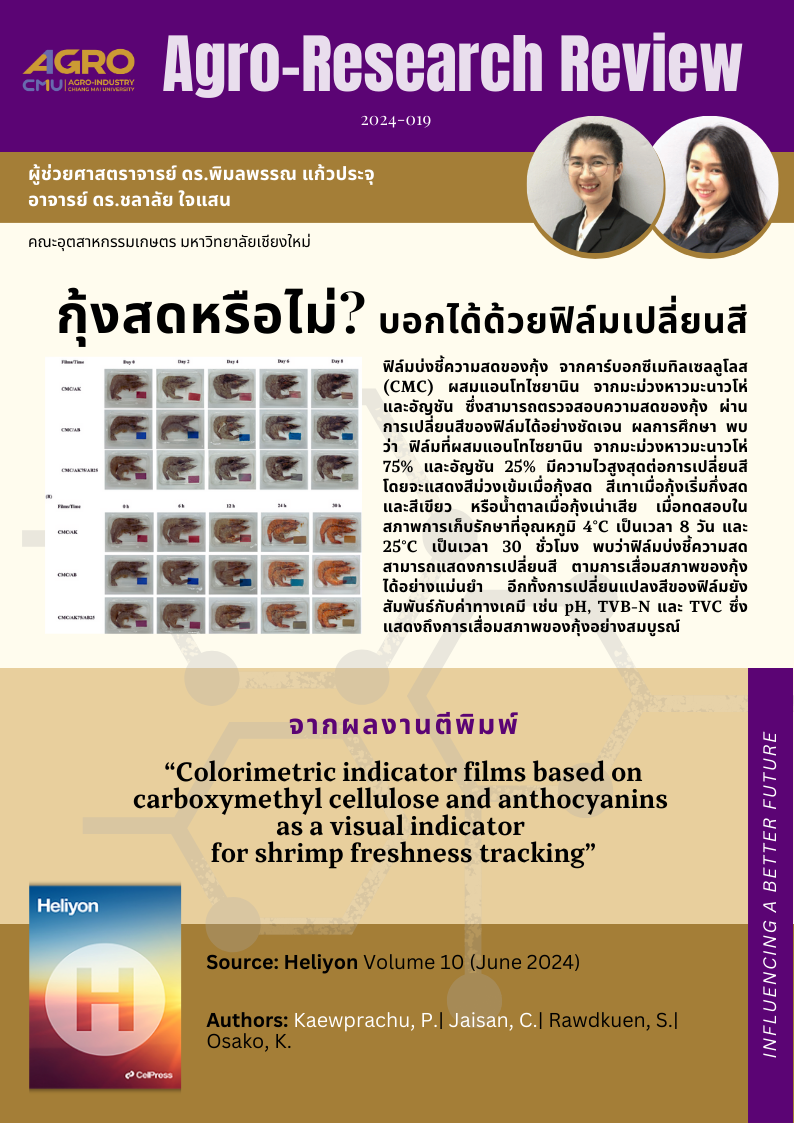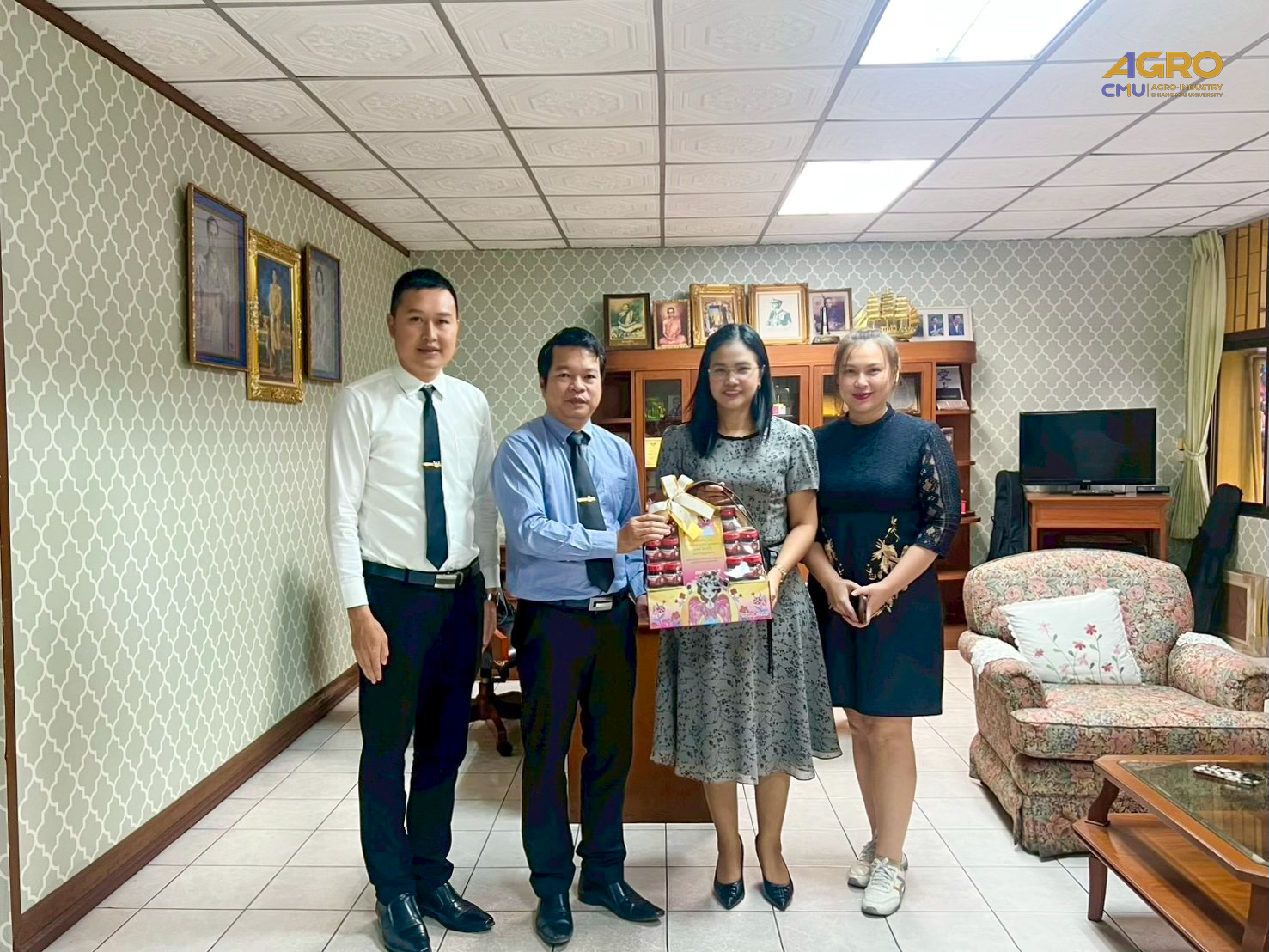
แนะนำงานวิจัย 2024-019 กุ้งสดหรือไม่? บอกได้ด้วยฟิล์มเปลี่ยนสี
ฟิล์มบ่งชี้ความสดของกุ้ง จากคาร์บอกซีเมทิลเซลลูโลส (CMC) ผสมแอนโทไซยานินจากมะม่วงหาวมะนาวโห่และอัญชัน ซึ่งสามารถตรวจสอบความสดของกุ้งผ่านการเปลี่ยนสีของฟิล์มได้อย่างชัดเจน ผลการศึกษาพบว่าฟิล์มที่ผสมแอนโทไซยานินจากมะม่วงหาวมะนาวโห่ 75% และอัญชัน 25% มีความไวสูงสุดต่อการเปลี่ยนสี โดยจะแสดงสีม่วงเข้มเมื่อกุ้งสด สีเทาเมื่อกุ้งเริ่มกึ่งสด และสีเขียวหรือน้ำตาลเมื่อกุ้งเน่าเสีย อีกทั้งการเปลี่ยนแปลงสีของฟิล์มยังสัมพันธ์กับค่าทางเคมี เช่น pH, TVB-N และ TVC ซึ่งแสดงถึงการเสื่อมสภาพของกุ้งอย่างสมบูรณ์
A freshness indicator film for shrimp was developed using carboxymethyl cellulose (CMC) combined with anthocyanins extracted from Karanda and butterfly pea. The film effectively detects shrimp freshness through distinct color changes. The study revealed that the film containing 75% anthocyanins from Karanda and 25% from butterfly pea exhibited the highest sensitivity to color changes. The film displayed a dark purple color when the shrimp were fresh, turned gray as the shrimp reached a semi-fresh state, and shifted to green or brown when the shrimp spoiled. Furthermore, these color changes correlated with chemical indicators such as pH, total volatile basic nitrogen (TVB-N), and total viable count (TVC), confirming the shrimp's degradation status.
Topic: Colorimetric indicator films based on carboxymethyl cellulose and anthocyanins as a visual indicator for shrimp freshness tracking
Authors: Kaewprachu, P.| Jaisan, C.| Rawdkuen, S.| Osako, K.
Abstract:
This study aimed to evaluate the response efficiency of colorimetric indicator films based on carboxymethyl cellulose (CMC) incorporated with different anthocyanins [Karanda alone (CMC/AK), butterfly pea alone (CMC/AB), and a mixture of anthocyanins from Karanda and butterfly pea (CMC/AK75/AB25)] for tracking shrimp freshness during storage at different temperatures and times (4 °C for 8 days and 25 °C for 30 h). The mathematical models were also applied to predict their freshness and shelf life. The CMC/AK75/AB25 indicator film was the most sensitive and clearly changed color, which could be distinguished by the naked eye. Color changes indicated the shrimp deterioration processes: dark purple (fresh), purplish gray or gray (semi-fresh), and olive green or brown (spoilage). During shrimp storage at temperatures of 4 and 25 °C, the pH reached 7.52 and 8.14, TVB-N 35.98 and 72.72 mg/100 g, and TVC 5.75 and 7.88 log CFU/g, respectively, indicating shrimp had completely deteriorated. Furthermore, there was a positive correlation between the ΔE value of the indicator film and both TVB-N and TVC. These findings suggest that the CMC/AK75/AB25 indicator film could serve as a real-time visual indicator for tracking shrimp freshness and could enhance the guarantee of shrimp safety.
Keywords: Anthocyanin; Carboxymethyl cellulose; Colorimetric indicator; Food spoilage; Shrimp freshness
View at publisher: https://www.sciencedirect.com/science/article/pii/S2405844024075583?via%3Dihub
#อกมช. #agrocmu #CMU





